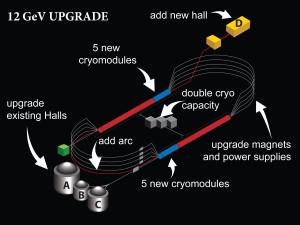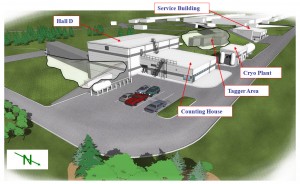Why don’t quarks fly solo?
Scientists have long observed that these particles, like Noah’s animals or instances of bad luck, always come in twos or threes. Yet nothing in the Standard Model of physics says quarks have to keep each other company.
Scientists at Jefferson Laboratory in Newport News, US, will soon be uniquely positioned to experimentally probe this curiosity, among others. Their CEBAF accelerator is getting a boost from six to twelve gigaelectronvolts (GeV) of electron beam energy, giving researchers more to play with as they explore the complex make-up of nucleons: their constituent quarks, the stubbornly strong gluons that hold them together and the resulting shapes of this subatomic assembly.
The 12 GeV Upgrade Project took a critical step on 13 May with the start of CEBAF’s first six-month shutdown for installation.

Schematic layout of the required facility modifications to realise the 12 GeV Upgrade. Image: DOE's Jefferson Lab
“It’s very exciting,” said Allison Lung, deputy project manager of the 12 GeV Upgrade Project. “We’ll be the first ones to map out these exotic particles that are rich in glue, really trying to understand why you never see one quark by itself or why they’re confined.”
CEBAF currently supports three experimental areas that probe the inner dynamics of neutrons and protons. With the 12-GeV upgrade, a fourth experimental hall will be built to house a new experiment, GlueX, aimed at getting to the bottom of quark confinement, which has been cited as one of the most pressing questions in physics today. Two of the existing halls will also get new spectrometer systems.
An addition of ten new superconducting-cavity cryomodules to the existing 40, arranged in two parallel linacs, will give the electron beam its extra 6 GeV. The cryomodules will be installed in what is currently drift space in the CEBAF accelerator, precluding the need to add length to the accelerator.
“That’s nice because it means we didn’t have to spend any money on expanding the tunnel,” said Leigh Harwood, associate project manager for the accelerator portion of the upgrade.
JLab’s pioneering advances in superconducting radiofrequency (SCRF) technology have helped streamline the cavity interface: the new coupling instrumentation carries far less bulk than its predecessors. Researchers can now place a seven-cell cavity in a space that would previously have been occupied by a five-cell structure. With more cells, the cavities’ accelerating voltages go up, and the particle beam can efficiently climb to higher energies. In addition, the developments at JLab, some in collaboration with ILC, led to higher gradients that have further increased the voltages. Once all is in place, CEBAF will house a total of 50 SCRF cryomodules in its linacs.
The new plan allows the electron beam to make up to five-and-a-half passes around its racetrack shape, imparting more energy to the beam with every lap. Scientists can select when during those five passes the electron beam leaves its accelerating orbit for a detector, so tuning how much beam energy to feed to CEBAF’s experiments – up to 11 GeV to the three current experimental halls and up to 12 GeV to the future fourth.
“We can pretty much dial it where we want, and then deliver it to three halls at the same time,” Lung said. “It’s like having three different accelerators.”

The Hall D sub-project consists of building a new large acceptance detector for photon beam experiments located in a new experimental hall at the northeast corner of the CEBAF accelerator. Image: DOE's Jefferson Lab
The construction of Hall D, the fourth experimental hall, will provide more than just another fundamental physics project. In the years leading up to completion of the upgrade, physics students, professors and researchers from collaborating universities will have a rare educational opportunity to actively participate in the design and tests of the detector experiment and equipment, as well as in the detector’s commissioning.
“We extensively involve universities in constructing the detectors for this upgrade to the tune of millions of dollars and dozens of institutions across the world,” Lung said. “We’ve really fine-tuned those collaborative relationships.”
The 12 GeV Upgrade Project is being funded by the US Department of Energy, with support from the National Science Foundation, which contributes to collaborating US universities, and with collaborative contributions from institutions in Canada, Chile, France and Russia.
“I started working on developing and planning the upgrade to CEBAF in ’98,” Harwood said. “I’m thrilled to see all the hard work coming to fruition and the transition actually starting.”
JLab will complete construction in 2015, and the fully fledged programme will begin in 2016.
“There’s so little new facility construction in the world for basic research,” Lung said. “To finally see this coming up out of the ground is very exciting.”

Recent Comments